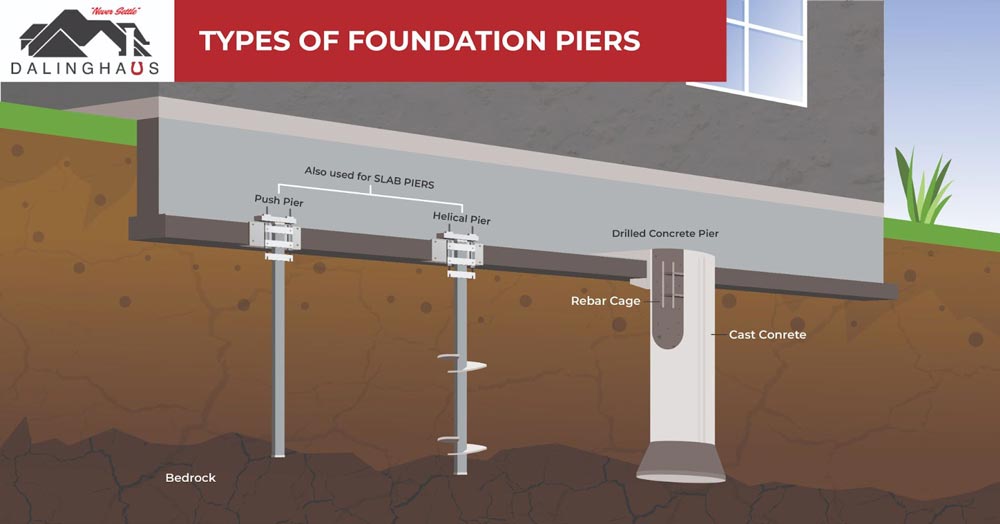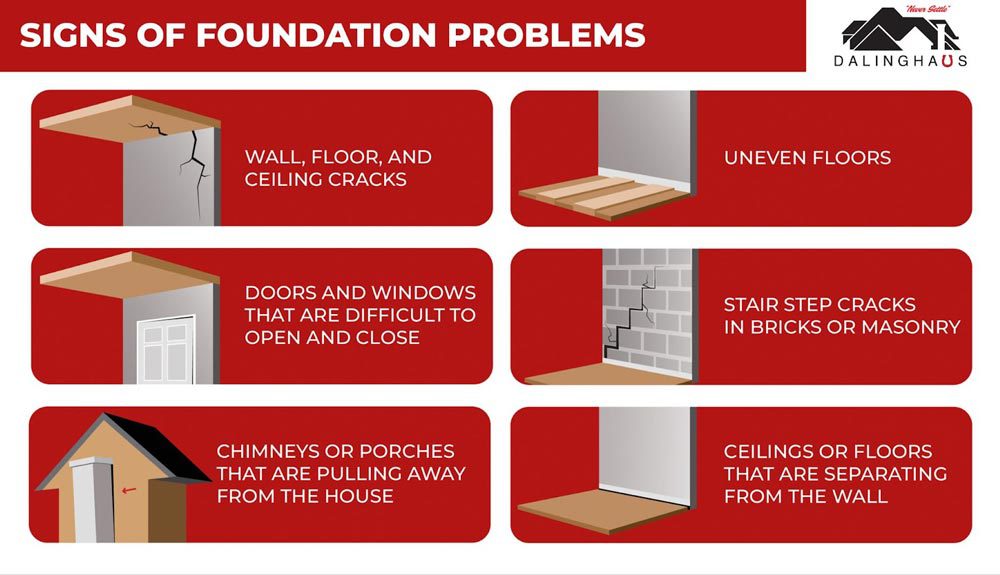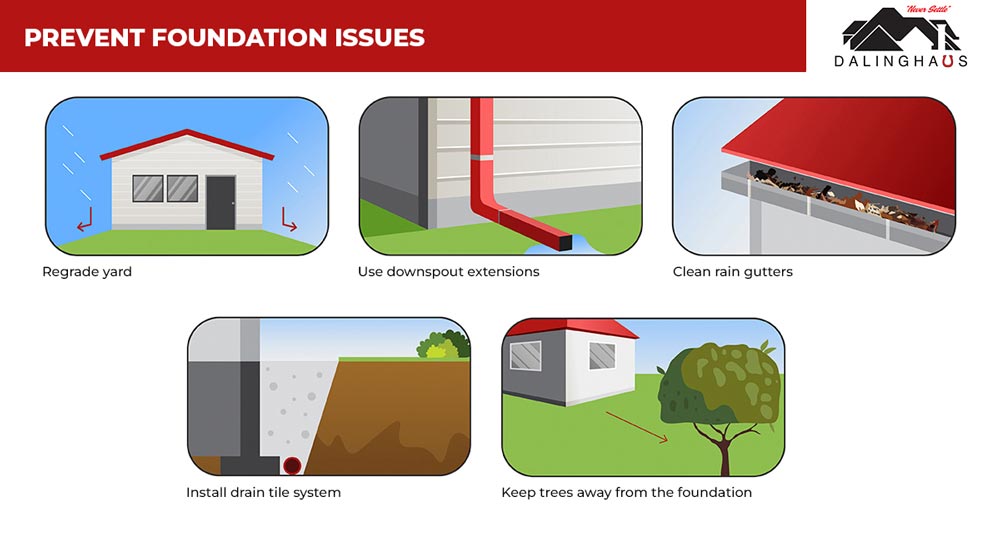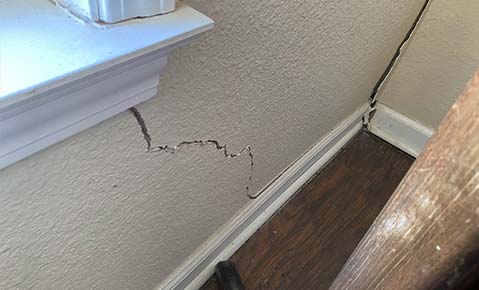Foundation problems can be a nightmare. Cracks in walls, uneven floors, and windows and doors that don’t open and close correctly are all signs of an issue beneath the surface. But does the foundation need to be replaced? The good news is that foundation replacement usually isn’t necessary. Most foundation problems can be repaired.
What Is a Foundation?
In construction, a foundation refers to the structural component that provides support and stability to a building. It is typically made of concrete, masonry, or steel, and is laid on the soil beneath the building.
The primary purpose of a foundation is to distribute the weight of the building evenly to the underlying soil. This prevents the building from sinking into the ground or becoming unstable during an earthquake or other natural disaster. Additionally, a foundation can help protect a building from water damage by elevating it above the ground.
Several types of foundations are used in construction, including shallow foundations (typically used for smaller buildings) and deep foundations (which are used for larger buildings and in areas with poor soil conditions).
Most Foundations Can Be Repaired
There are various reasons why a foundation can become damaged, including soil issues, water damage, and poor construction techniques. Fortunately, most of these problems can be mitigated through various repair methods such as underpinning using push, helical, or slab piers or repairing crawl space foundation walls using carbon fiber.

When Is Foundation Replacement Necessary?
Foundation replacement is typically necessary when the foundation walls have severely deteriorated. In such instances, the foundation’s structural integrity is compromised and it can no longer support the weight of the building, rendering it unsafe for occupation.
It is critical to note that even when foundation replacement is necessary, it’s usually only one or two walls that need to be replaced. The rest of the foundation can be salvaged with minor repairs and reinforcement. However, this largely depends on the extent of the damage.
One of the telltale signs that foundation replacement is necessary is the presence of large cracks on the foundation walls. These cracks could be horizontal, vertical, or diagonal, and may vary in size and shape. Additionally, there may be very significant settling or sinking of the foundation, causing the building to tilt or lean precariously.
Another vital factor to consider when deciding whether to replace a foundation is the age of the building. Older buildings, in particular, may have foundation walls that are not up to modern-day standards and could require replacement to meet current safety regulations.
Ultimately, the decision to replace a foundation should be made after a thorough assessment by a qualified structural engineer or foundation repair specialist. They will be able to identify the extent of the damage, recommend appropriate solutions, and determine whether replacement is necessary.
How Is Foundation Replacement Done?
Step 1 – Lift the building
The first step in foundation replacement is to lift the building using hydraulic jacks that are strategically positioned on the existing foundation. This is done slowly and carefully to ensure that the process is safe and the building is not damaged. Steel beams or temporary support structures may also stabilize the building during lifting.
Step 2 – Remove the old foundation
Once the building is raised to the desired height, the old foundation is removed using heavy machinery such as excavators or jackhammers. The old foundation must be demolished carefully in order to avoid damaging the building and any surrounding structures. The excavation area is then cleaned and prepared for the new foundation.
Step 3 – Build the new foundation
The next step is the construction of the new foundation walls. This is done by pouring cement into forms strategically placed around the perimeter of the excavation area or using concrete blocks. Rebar or steel reinforcement may be added to increase the foundation’s strength.
Step 4 – Lower the building onto the new foundation
After the new foundation walls are built, the building is lowered onto the new foundation using the same hydraulic jacks used to lift it. The building is then anchored to the new foundation using bolts or other fasteners.
Step 5 – Completion and tidying up
Finally, the excavation area is backfilled with soil and compacted to provide a stable base around the new foundation. Landscaping or paving may also be added as needed to complete the project.
How Much Does Foundation Replacement Cost?
Generally, the cost of foundation replacement will depend on whether a full or partial replacement is required. If only a few foundation sections need to be replaced, the overall price will be lower than if an entire foundation needed to be dug up and replaced.
Additionally, the type of foundation will significantly impact the cost. For instance, a house with a slab foundation may be more straightforward to replace than a basement foundation, which is more complicated to remove and replace.
Another major factor that influences foundation replacement cost is the property’s location. For example, the cost of foundation replacement in an area with harsh winter weather can be higher due to the necessary use of heavy equipment to dig deep into frozen ground. Additionally, some cities may require specific permits or inspections before starting foundation replacement work, which can increase the overall cost.
To give a rough estimate, foundation replacement can range anywhere from $20,000 to $100,000 or more, depending on the property’s size, type, and location. Homeowners should always obtain several estimates from reputable contractors before making a decision. Ensuring that the contractor is licensed and insured with experience in foundation replacement work is vital.
Common Signs of Foundation Problems
Some of the most common signs of foundation issues include the following:

- Wall, floor, and ceiling cracks
- Uneven floors
- Doors and windows that are not opening and closing correctly
- Stair step cracks in brick or masonry
- Chimneys and porches that are pulling away from the house
- Walls that aren’t in contact with the ceiling or floor
If you notice any of these signs, it’s crucial to have your foundation checked by a professional foundation repair contractor. You do not want to sweep these issues under the rug, as they can lead to more severe structural problems if left unaddressed.
What Causes Foundation Problems?
When it comes to foundation problems, several factors can contribute to them happening:
- Expansive soil – Expansive soil contains a significant amount of clay, which swells when it absorbs water and shrinks when it dries out. This can lead to movement in the soil, putting pressure on the foundation and causing it to shift or crack over time.
- Erosion-prone soil – Soil that is prone to erosion can wash away over time, creating voids under the foundation.
- Improper soil compaction – This occurs when the soil is not compacted to its required density before construction starts, which can lead to settling and shifting of the foundation.
- Seismic events – Seismic events can cause the ground to shake and shift, potentially leading to foundation damage.
- Poor drainage – Water that collects around the foundation can cause the soil to become saturated, leading to instability and movement.
It is important to note that identifying the specific cause of foundation problems can be a complex process, and may require the expertise of a professional. If you suspect that your foundation may be compromised, it is essential to address the issue quickly to prevent further damage and ensure the safety of your home or building.
How to Help Prevent Foundation Trouble
Since most foundation problems are caused by excess moisture in the soil around the foundation, the best way to prevent trouble is to control groundwater around the foundation. Here are some ways to do that:

- Regrade your yard – Regrading involves reshaping the soil around the foundation so that rainwater flows away from the foundation instead of towards it. This can help prevent water from seeping into the foundation and causing damage.
- Install downspout extensions – Downspouts that are too short will deposit large amounts of water close to the foundation, leading to issues. Adding extensions to your downspouts can redirect the water further away from the foundation.
- Clean gutters regularly – Clogged gutters can cause water to overflow, run down the side of the house, and soak into the ground around the foundation. Cleaning your gutters regularly (at least twice a year) can prevent water from causing potential foundation problems.
- Install a drain tile system – A drain tile system involves installing a network of buried, perforated pipes diverting water away from the foundation and towards a designated drainage area.
- Keep trees away from the foundation – Trees can cause severe damage to foundations through their root systems. As the roots expand, they can cause the foundation to shift and crack. Keeping trees at least 50 feet away from the foundation is recommended.
If you’re concerned that your home might have a foundation problem, contact us today to schedule a free foundation evaluation. If we find a problem, we’ll provide you with a repair estimate. We serve Southern California, Arizona, and Nevada.






